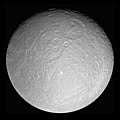Fasciculus:PIA07763 Rhea full globe5.jpg

Mensura huius perspectionis: 600 × 600 elementa imaginalia. Aliae mensurae: 240 × 240 elementa imaginalia | 480 × 480 elementa imaginalia | 768 × 768 elementa imaginalia | 1 024 × 1 024 elementa imaginalia | 2 048 × 2 048 elementa imaginalia | 4 920 × 4 920 elementa imaginalia.
Sua resolutio (4 920 × 4 920 elementa imaginalia, magnitudo fasciculi: 2.67 megaocteti, typus MIME: image/jpeg)
Historia fasciculi
Presso die vel tempore fasciculum videbis, sicut tunc temporis apparuit.
| Dies/Tempus | Minutio | Dimensiones | Usor | Sententia | |
|---|---|---|---|---|---|
| recentissima | 07:15, 27 Augusti 2018 |  | 4 920 × 4 920 (2.67 megaocteti) | PlanetUser | Reverted to version as of 08:13, 13 March 2015 (UTC) |
| 10:09, 15 Augusti 2018 |  | 4 920 × 4 920 (2.66 megaocteti) | The NMI User | Reverted to version as of 23:49, 14 August 2018 (UTC) | |
| 23:59, 14 Augusti 2018 |  | 4 920 × 4 920 (2.64 megaocteti) | The NMI User | rv, fixed | |
| 23:49, 14 Augusti 2018 |  | 4 920 × 4 920 (2.66 megaocteti) | The NMI User | Try making black | |
| 23:44, 14 Augusti 2018 |  | 4 920 × 4 920 (2.65 megaocteti) | The NMI User | Fixed | |
| 08:09, 13 Augusti 2018 |  | 4 920 × 4 920 (3.67 megaocteti) | The NMI User | Removing black borders | |
| 08:01, 13 Augusti 2018 |  | 4 920 × 4 920 (2.67 megaocteti) | The NMI User | Reverted to version as of 08:13, 13 March 2015 (UTC) | |
| 07:56, 13 Augusti 2018 |  | 4 920 × 4 920 (5.67 megaocteti) | The NMI User | Black background | |
| 08:13, 13 Martii 2015 |  | 4 920 × 4 920 (2.67 megaocteti) | MoreTomorrow | making square (to match other planet/moon images) | |
| 06:43, 30 Octobris 2008 |  | 4 920 × 4 820 (2.68 megaocteti) | WolfmanSF | This is the same full-resolution NASA image, with black panels added to the margins and some Photoshop processing to enhance contrast. |
Nexus ad fasciculum
Ad hunc fasciculum nectit:
Usus fasciculi per inceptus Vicimediorum
Quae incepta Vici fasciculo utuntur:
- Usus in af.wikipedia.org
- Usus in an.wikipedia.org
- Usus in ar.wikipedia.org
- ريا
- ريا (قمر)
- جيوفاني دومينيكو كاسيني
- قالب:المجموعة الشمسية
- قائمة أجرام المجموعة الشمسية مرتبة حسب الحجم
- قائمة الأجرام المستديرة بالجاذبية في المجموعة الشمسية
- قائمة الأقمار الطبيعية
- خط زمني لاكتشاف كواكب المجموعة الشمسية وأقمارها
- اكتشاف واستكشاف النظام الشمسي
- قائمة أنواع الكواكب
- مهمة نظام تيتان زحل
- قائمة أكبر الفوهات في المجموعة الشمسية
- 1981 ميداس
- حلقات ريا
- قالب:ريا (قمر)
- Usus in ary.wikipedia.org
- Usus in arz.wikipedia.org
- Usus in ast.wikipedia.org
- Usus in as.wikipedia.org
- Usus in azb.wikipedia.org
- Usus in be.wikipedia.org
- Usus in bh.wikipedia.org
- Usus in ca.wikipedia.org
- Usus in ckb.wikipedia.org
- Usus in cy.wikipedia.org
- Usus in de.wikipedia.org
- Usus in el.wikipedia.org
- Usus in en.wikipedia.org
View more global usage of this file.


